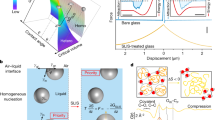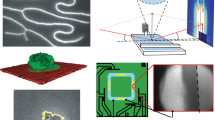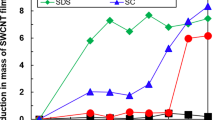Abstract
Thin inorganic membranes are of importance to a number of applications such as sensing, catalysis and separation. Here, we present a method to fabricate free-standing sheets of various inorganic materials such as C, Si, Pt, Fe and CdSe with thicknesses ranging from a few to a hundred nanometres. First, an array of holes in a flat substrate was uniformly covered by dried-foam-film (DFF) self-standing reversed bilayers of surfactants. As the surfactant bilayers are sufficiently robust to allow deposition of amorphous films, a variety of inorganic films were then fabricated on the DFFs using physical deposition techniques such as sputtering, electron-beam deposition and thermal deposition. The films thus obtained showed improved thermal stability compared with the DFFs. This fabrication method therefore provides a flexible and reliable way to readily produce free-standing inorganic multilayered structures.
This is a preview of subscription content, access via your institution
Access options
Subscribe to this journal
Receive 12 print issues and online access
$259.00 per year
only $21.58 per issue
Buy this article
- Purchase on Springer Link
- Instant access to full article PDF
Prices may be subject to local taxes which are calculated during checkout






Similar content being viewed by others
References
Baker, R. W. Membrane Technology and Applications (Wiley, Hoboken, 2004).
DeSilva, M. S. et al. Impedance based sensing of the specific binding reaction between Staphylococcus enterotoxin B and its antibody on an ultra-thin platinum film. Biosens. Bioelectron. 10, 675–682 (1995).
Xu, C. et al. Low temperature CO oxidation over unsupported nanoporous gold. J. Am. Chem. Soc. 129, 42–43 (2007).
Freeman, B., Yampolskii, Y. & Pinnau, I. Materials Science of Membranes for Gas and Vapor Separation (Wiley, Hoboken, 2006).
Raman, N. K. & Brinker, C. J. Organic template approach to molecular-sieving silica membranes. J. Membrane Sci. 105, 273–279 (1995).
Kanellopoulos, N. K. Recent Advances in Gas Separation by Microporous Ceramic Membranes (Elsevier, Amsterdam, 2000).
Toh, C.-S., Kayes, B. M., Nemanick, E. J. & Lewis, N. S. Fabrication of free-standing nanoscale alumina membranes with controllable pore aspect ratios. Nano Lett. 4, 767–770 (2004).
Striemer, C. C., Gaborski, T. R., McGrath, J. L. & Fauchet, P. M. Charge- and size-based separation of macromolecules using ultrathin silicon membranes. Nature 445, 749–753 (2007).
Wu, Z. et al. Transparent, conductive carbon nanotube films. Science 305, 1273–1276 (2004).
Zhang, D. et al. Transparent, conductive, and flexible carbon nanotube films and their application in organic light-emitting diodes. Nano Lett. 6, 1880–1886 (2006).
Jin, J., Huang, J. & Ichinose, I. Dried foam films: Self-standing, water-free, reversed bilayers of amphiphilic compounds. Angew. Chem. Int. Edn 44, 4532–4535 (2005).
José-Yacamán, M. et al. Surface diffusion and coalescence of mobile metal nanoparticles. J. Phys. Chem. B 109, 9703–9711 (2005).
Yang, D., Zhang, G., Sacher, E., José-Yacamán, M. & Elizondo, N. Evidence of the interaction of evaporated Pt nanoparticles with variously treated surfaces of highly oriented pyrolytic graphite. J. Phys. Chem. B 110, 8348–8356 (2006).
Cai, C., Diao, D., Ma, W. & Yan, Y. Carbon films deposited by MCECR plasma sputtering. Vacuum 80, 939–943 (2006).
Casiraghi, C., Ferrari, A. C. & Robertson, J. The smoothness of tetrahedral amorphous carbon. Diamond Relat. Mater. 14, 913–920 (2005).
Israelachvili, J. N. Intermolecular & Surface Forces (Academic, London, 1991).
Castellana, E. T. & Cremer, P. S. Solid supported lipid bilayers: From biophysical studies to sensor design. Surf. Sci. Rep. 61, 429–444 (2006).
Asaka, K., Ottova, A. & Tien, H. T. Mediated electron transfer across supported bilayer lipid membrane (s-BLM). Thin Solid Films 354, 201–207 (1999).
Bélorgey, O. & Benattar, J. J. Structural properties of soap black films investigated by X-ray reflectivity. Phys. Rev. Lett. 66, 313–316 (1991).
Mileva, E. & Exerowa, D. Foam films as instrumentation in the study of amphiphile self-assembly. Adv. Colloid Interface Sci. 100–102, 547–562 (2003).
Mamedov, A. A. et al. Molecular design of strong single-wall carbon nanotube/polyelectrolyte multilayer composites. Nature Mater. 1, 190–194 (2002).
Jiang, C., Markutsya, S., Pikus, Y. & Tsukruk, V. V. Freely suspended nanocomposite membranes as highly sensitive sensors. Nature Mater. 3, 721–728 (2004).
Ono, S. S. & Decher, G. Preparation of ultrathin self-standing polyelectrolyte multilayer membranes at physiological conditions using pH-responsive film segments as sacrificial layers. Nano Lett. 6, 592–598 (2006).
Vendamme, R., Onoue, S., Nakao, A. & Kunitake, T. Robust free-standing nanomembranes of organic/inorganic interpenetrating networks. Nature Mater. 5, 494–501 (2006).
Nolte, M., Schoeler, B., Peyratout, C. S., Kurth, D. G. & Fery, A. Filled microcavity arrays produced by polyelectrolyte multilayer membrane transfer. Adv. Mater. 17, 1665–1669 (2005).
Acknowledgements
The authors would like to thank K. Kurashima, Materials Analysis Station, NIMS, for his advice on TEM measurements.
Author information
Authors and Affiliations
Contributions
J.J. was responsible for the preparation of dried foam films, thermal deposition of carbon, ion sputtering of Pt and characterization of all inorganic sheets, including Si, Te, Fe, In and CdSe. Y.W. was responsible in particular for e-beam deposition of silicon and thermal deposition of Te, Fe, In and CdSe. X.P. contributed to HR-TEM measurements. J.J. and I.I. were responsible for experimental design and manuscript preparation. I.I. was responsible for project planning.
Corresponding author
Ethics declarations
Competing interests
The authors declare no competing financial interests.
Supplementary information
Supplementary Information
Supplementary information and figures S1-S5 (PDF 1824 kb)
Rights and permissions
About this article
Cite this article
Jin, J., Wakayama, Y., Peng, X. et al. Surfactant-assisted fabrication of free-standing inorganic sheets covering an array of micrometre-sized holes. Nature Mater 6, 686–691 (2007). https://doi.org/10.1038/nmat1980
Received:
Accepted:
Published:
Issue Date:
DOI: https://doi.org/10.1038/nmat1980
This article is cited by
-
Surface acoustic wave humidity sensors based on uniform and thickness controllable graphene oxide thin films formed by surface tension
Microsystems & Nanoengineering (2019)
-
Photosensitive free-standing ultra-thin carbyne–gold films
Optical and Quantum Electronics (2019)
-
Dynamically arrested micelles in a supercooled sugar urea melt
Communications Chemistry (2018)
-
Replication of flexible polymer membranes with geometry-controllable nano-apertures via a hierarchical mould-based dewetting
Nature Communications (2014)
-
A glucose biosensor based on direct electrochemistry of glucose oxidase immobilized onto platinum nanoparticles modified graphene electrode
Science China Physics, Mechanics and Astronomy (2012)



